June 2023 marked the 25th Anniversary of Gramercy! Thank you to our valued investors, trusted business partners and team members without whom this milestone could not have been reached. We are excited for the opportunities we see ahead, and look forward to continuing to deliver upon our mission to have a positive impact on the well-being of our clients, portfolio investments (and their communities) and our team members.
Contents
Market Overview
Macro Review
The Federal Reserve removed its tightening bias. This theme began with the Bank of Canada and the ECB the week before, but the Federal Reserve and Bank of England followed with dovish statements. The nature of the press releases saw that one MPC voter at the Bank of England called for a cut at the February meeting. However, Chair Powell ducked and dived through the Q&A session and ultimately ruled out an interest rate cut in March. He even seemed to suggest that the December Summary of Economic Projections appeared outdated, which would imply more than the three cuts that Fed officials forecast. Meanwhile, the IMF’s World Economic Outlook painted a more resilient picture with moderating inflation and steady global growth as the probability of a hard landing scenario recedes. Global GDP was revised higher to 3.1%, with U.S. and EM growth expectations of 2.1% and 4.1% in 2024, respectively. Yet, the alarm bells in financial markets rang with Bancorp falling 45% this week after earnings and broader concerns around U.S. commercial real estate (Japan’s Aozora Bank also fell -34% this week). The sector of U.S. regional banks endured a volatile week. Across EM, comfort rose in Bolivia’s precarious fiscal position; Ecuador paid $273m in interest on its restructured global bond on Wednesday; and Brazil, Chile and Colombia cut interest rates. Ukraine is set to receive €50bn from the EU and Hungary did not veto the plan; Egypt is anticipating an even larger IMF deal with expectations now up to $10bn; and Benin announced a USD debut bond mandate. In Asia, Indian government bond yields gapped lower on the fiscal update; a Filipino corporate opted not to issue bonds given weak investor appetite; and China’s manufacturing activity shrank for the fourth consecutive month. In fact, the continued weakness in China saw 10-year yields fall to the lowest since 2002.
EM Credit Update
Emerging markets sovereign credit (cash bonds) ended the week up 1.2% with credit spreads 1bp wider. Sovereign outperformers were Bolivia, Ghana and Tajikistan, while Venezuela, Ukraine and Tunisia underperformed. EM sovereign spreads are 17bps wider YTD, but total returns are now only down 0.5%, having been down 2.2% in the second week of January. We have seen a combination of decompression into month-end with high yield bonds outperforming investment grade, but also via the helping hand of the U.S. Treasury market as yields fell 15-28bps this week.
The Week Ahead
The direction of travel will somewhat be determined by Fedspeak as officials seek to steer on the timing of the first rate cut. Key interest rate decisions are due from Australia (4.35%), Czech Republic (6.75%), India (6.50%), Mexico (11.25%), Peru (6.50%), Poland (5.75%) and Thailand (2.50%). EM inflation data is then expected out of Hungary, Philippines, Taiwan, Thailand, Turkey and Ukraine. However, the theme is instead likely to center around deflation with Chinese CPI and PPI data. Finally, elections in El Salvador come before Pakistan’s electorate head to the polls on Thursday.
Highlights from emerging markets discussed below: Argentina receives IMF board approval on $4.7bn; Omnibus bill discussions ongoing, Egypt IMF program upsize rumored while FX pressure builds and Synchronized monetary easing by LatAm central banks as Brazil, Chile and Colombia cut rates.
Fixed Income

Equities
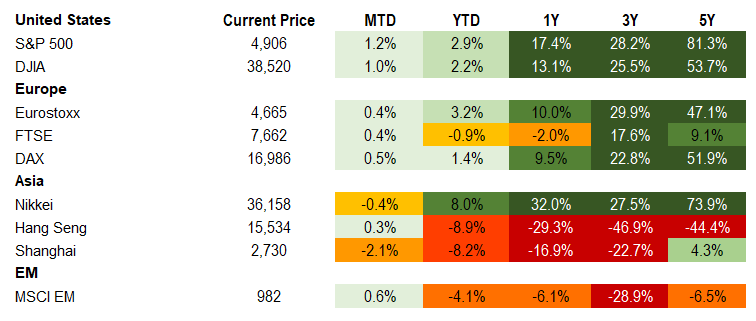
Commodities

Source for data tables: Bloomberg, JPMorgan, Gramercy. EM Fixed Income is represented by the following JPMorgan Indicies: EMBI Global, GBI-EM Global Diversified, CEMBI Broad Diversified and CEMBI Broad High Yield. DM Fixed Income is represented by the JPMorgan JULI Total Return Index and Domestic High Yield Index. Fixed Income, Equity and Commodity data is as of February 2, 2024 (mid-afternoon).
Emerging Markets Weekly Highlights
Argentina receives IMF board approval on $4.7bn; omnibus bill receives general approval in Lower House
Event: The IMF board approved the pending $4.7bn disbursement and extended the existing EFF maturity to December from September. The newly updated macroeconomic assumptions envisage an economic contraction of 2.8% this year followed by a rebound to 5.0% next year, overall fiscal balance, and a current account surplus of 0.9% of GDP. The press release highlights the authorities’ commitment to the elimination of distortive exchange rate restrictions and multiple FX rates in the near-term as well as plans to gradually unwind capital controls as conditions permit. Meanwhile, Milei’s labor reform was ruled unconstitutional and the evolving omnibus bill passed in the Lower House on general terms (144 vs. 109) but with specific articles to remain under discussion next week.
Gramercy Commentary: The IMF announcement was a well-anticipated constructive development. We continue to expect near-term noise and volatility as Milei navigates the political and social complexities of the ongoing macroeconomic adjustment. Regardless of the ultimate fate and composition of the ominous bill, we believe the authorities should be able to execute on a sizeable fiscal adjustment that at least brings the primary deficit into balance. Importantly, the FX reserve trajectory should continue to gradually improve with a better harvest, energy balance, and exchange rate policy evolution.
Egypt IMF program upsize rumored while FX pressure builds
Event: Following meetings between staff level officials and Egyptian authorities, speculation over a long anticipated upsize to the country’s existing $3bn EFF program to a range of $6-$15bn mounted. At the same time, dollar liquidity pressures increased as the parallel rate touched 70 EGP per USD vs. the official rate of 30 EGP per USD. The Central Bank unexpectedly hiked its policy rate by 200bps to 21.25%.
Gramercy Commentary: The prolonged delay of the pending 1st and 2nd reviews of the current EFF program combined with the impact of the ongoing regional conflicts on Suez Canal and tourism receipts have pressured Egypt’s already strained external liquidity position. We expect an agreement to be reached on a larger program, likely in the middle of the range, and to be accompanied by another FX adjustment as well as additional funds from the World Bank and potentially the EU. While this should ultimately be a constructive outcome, the continued uncertainty over the timing, size and scope of the FX adjustment and near-term disbursements leaves Egyptian balance of payments in an increasingly precarious position, increasing the risk of disorderly devaluation and default.
Synchronized monetary easing by LatAm central banks as Brazil, Chile and Colombia cut rates
Event: This week three of Latin America’s major central banks lowered their benchmark interest rates, on the same day the U.S. Federal Reserve signaled that its own policy easing cycle might not start until mid-year. The central banks of Brazil (BCB) and Chile (BCCh) met consensus market expectations lowering rates by 50bps (to 11.25%) and 100bps (7.25%), respectively. Colombia’s policymakers (BanRep) remained more cautious, opting for a below-consensus 25bps cut to 12.75% to mitigate risks of potential reversal in the current disinflation trend.
Gramercy Commentary: On the back of early and aggressive tightening of monetary policy when inflationary pressures spiked in the wake of the global pandemic, policymakers in some of LatAm’s major economies are currently benefiting from significantly improved inflation dynamics and outlooks. Year-on-year headline inflation has moderated to 4.6% in Brazil (from a peak of 12.1% in April 2022), 3.9% in Chile (from a peak of 14.1% in August 2022), and 9.3% in Colombia (from a peak of 13.3% in March 2023), and outlooks appear to remain favorable. The disinflation trends have crystalized solid real interest rates in these economies, which enables policymakers to maintain easing cycles without jeopardizing FX stability and with relatively limited contagion risks from the Fed’s and other systemic central banks’ policy decisions. In this context, from an EM local assets perspective, the LatAm stories supported by disinflation trends and high real rates remain among our preferred investment themes this year.
Emerging Markets Technicals
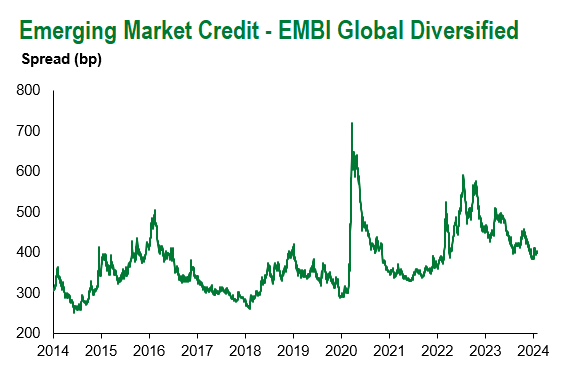
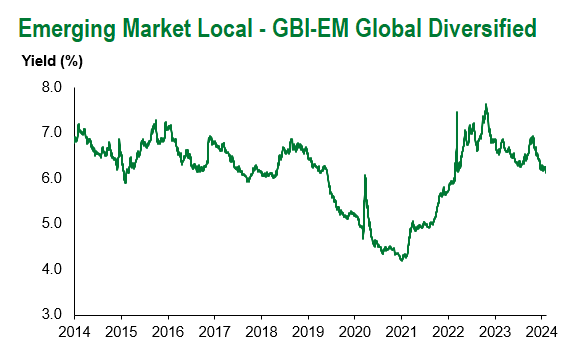
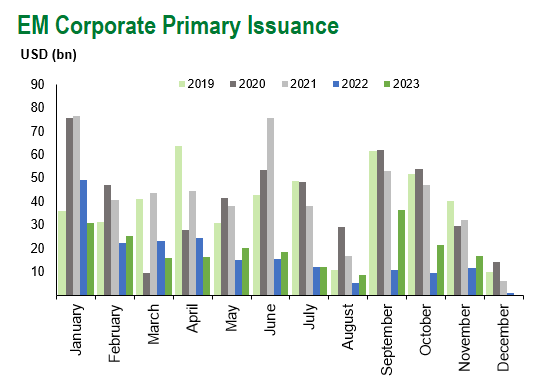
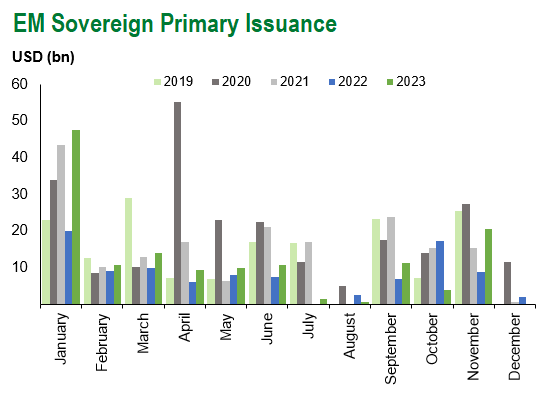
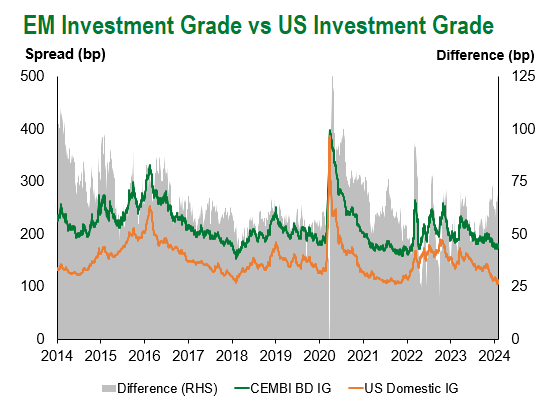
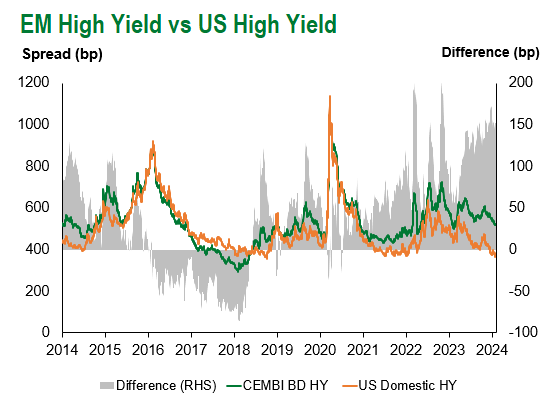
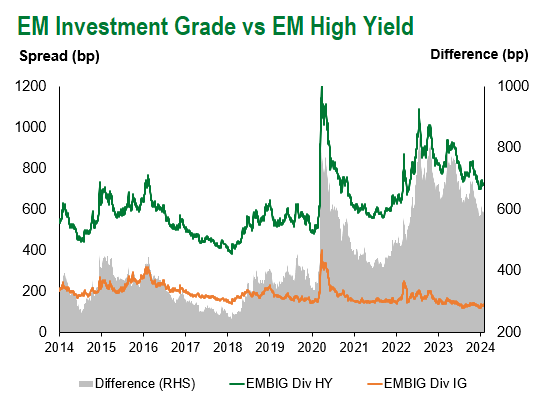
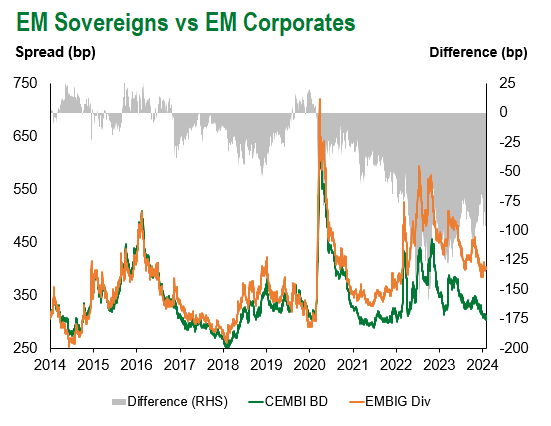
Emerging Markets Flows
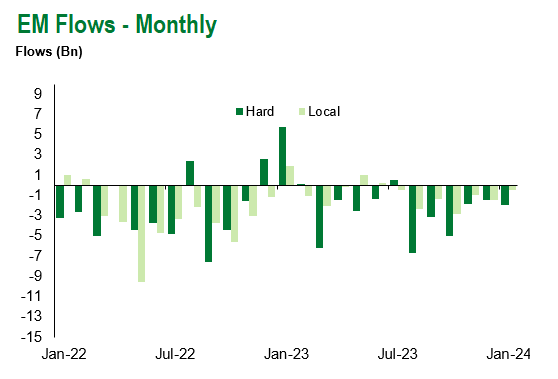
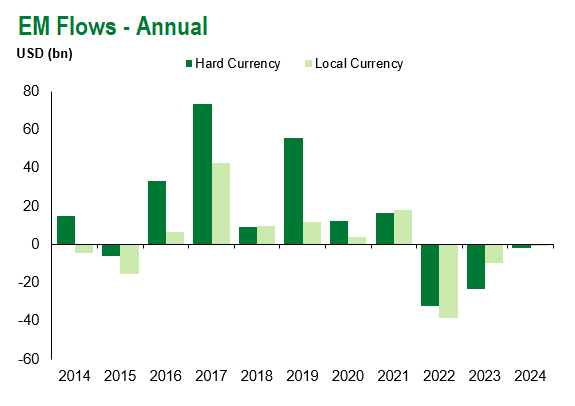
Source for graphs: Bloomberg, JPMorgan, Gramercy. As of February 2, 2024.
For questions, please contact:
Kathryn Exum, CFA ESG, Director, Co-Head of Sovereign Research, [email protected]
Petar Atanasov, Director, Co-Head of Sovereign Research, [email protected]
James Barry, Director, Deputy Portfolio Manager, [email protected]
This document is for informational purposes only. The information presented is not intended to be relied upon as a forecast, research or investment advice, and is not a recommendation, offer or solicitation to buy or sell any securities or to adopt any investment strategy. Gramercy may have current investment positions in the securities or sovereigns mentioned above. The information and opinions contained in this paper are as of the date of initial publication, derived from proprietary and nonproprietary sources deemed by Gramercy to be reliable, are not necessarily all-inclusive and are not guaranteed as to accuracy. This paper may contain “forward-looking” information that is not purely historical in nature. Such information may include, among other things, projections and forecasts. There is no guarantee that any forecasts made will come to pass. Reliance upon information in this paper is at the sole discretion of the reader. You should not rely on this presentation as the basis upon which to make an investment decision. Investment involves risk. There can be no assurance that investment objectives will be achieved. Investors must be prepared to bear the risk of a total loss of their investment. These risks are often heightened for investments in emerging/developing markets or smaller capital markets. International investing involves risks, including risks related to foreign currency, limited liquidity, less government regulation, and the possibility of substantial volatility due to adverse political, economic or other developments. References to any indices are for informational and general comparative purposes only. The performance data of various indices mentioned in this update are updated and released on a periodic basis before finalization. The performance data of various indices presented herein was current as of the date of the presentation. Please refer to data returns of the separate indices if you desire additional or updated information. Indices are unmanaged, and their performance results do not reflect the impact of fees, expenses, or taxes that may be incurred through an investment with Gramercy. Returns for indices assume dividend reinvestment. An investment cannot be made directly in an index. Accordingly, comparing results shown to those of such indices may be of limited use. The information provided herein is neither tax nor legal advice. Investors should speak to their tax professional for specific information regarding their tax situation.
